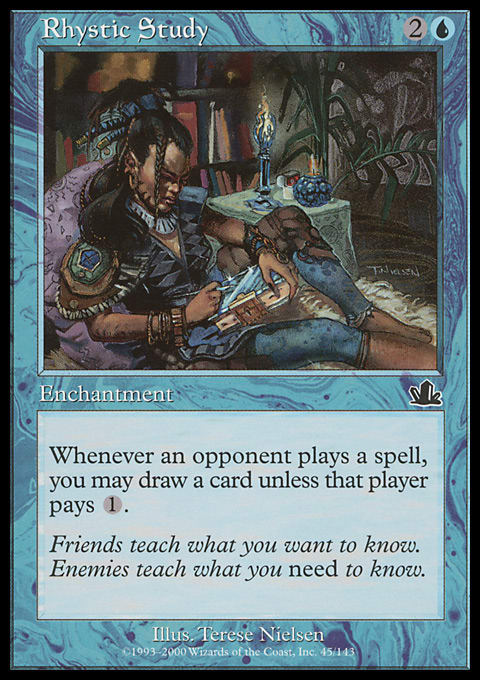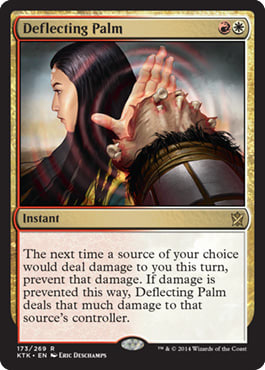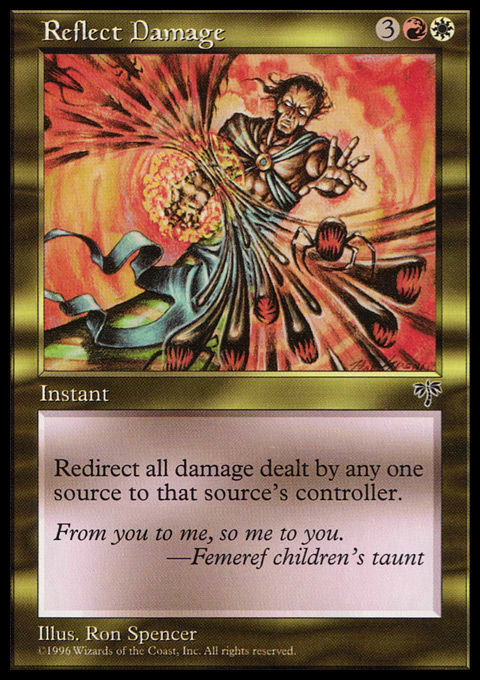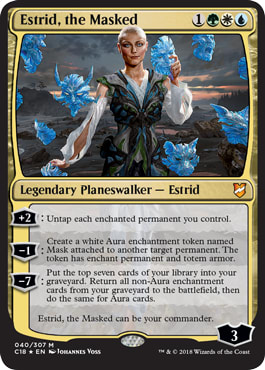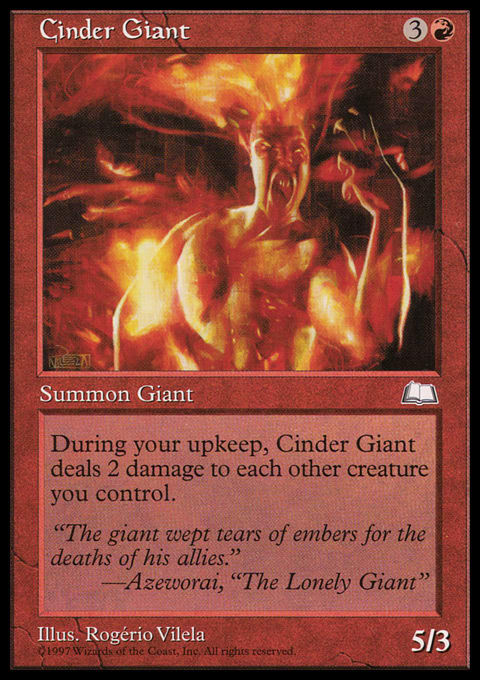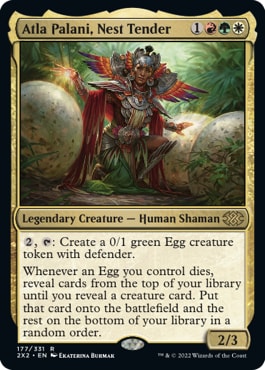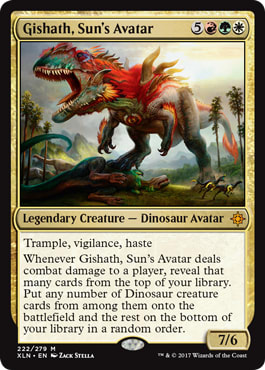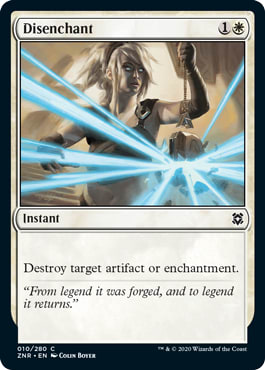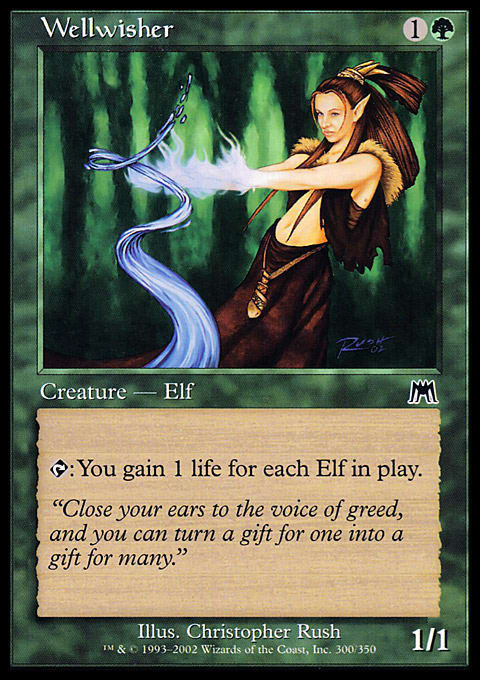That is, until I went looking.
I knew not whether my compulsion was driven by greed for her power or a mere desire to look upon her face, but either infatuation was enough to drive the journey over weeks.
In the end, it was folly. One I'm fortunate to have walked away from, as I realized a great many others had not. For while my quest to meet this famed enchantress was a success, it taught me a bitter truth:
Surprises, by their very nature, come out of nowhere.
Among the sheer thousands of cardboard choices with which to construct a Commander arsenal, the top tier are well recognized. The Demonic Tutors, Cyclonic Rifts, and Smothering Tithes of the format have all repeatedly proven their power level, and frequently have price tags to match. These titans wear efficiency and raw strength right on their sleeves. Their potential is apparent from the get-go. Eyes may roll at the sight of yet another Rhystic Study hitting the table, but folks are seldom surprised. For that, we need to dig deeper into the archives.
With such a grand library of choices, it's inevitable that many Magic cards fall through the cracks, or have been rendered obsolete by stronger alternatives. While the overall power level of the game grows and evolves over time, don't be too quick to assume one card is strictly better than another. For example, while Deflecting Palm can initially appear strictly superior to Reflect Damage, the latter avoids any targeting clause, ignoring Hexproof and Shroud. Reflect Damage also counts all the damage dealt by a source, meaning an opposing Blasphemous Act is quite likely to kill the foolish mage who cast it. Reflect Damage is cheaper, faster, and easier to leave open, but that doesn't mean Reflect Damage should be overlooked. It has that great potential to surprise an entire table.
It's these easy-to-overlook cards that are the subject of today's adventure: a second look into innocuous pieces of cardboard that play much better than they appear at first glance. Or perhaps they have a niche application in which to shine? A bonus to having these cards be largely underplayed is they'll often be quite budget friendly, often coming in at under $1.00. Their obscurity also lends itself to a surprise-factor, making it easier to catch opponents off-guard.
So light up that torch! We're venturing deep into the dungeon to rediscover which Commander cards are better than they look. Here's hoping we find some treasures along the way. Avoid any chests that appear to be growling. Best to let sleeping Mimics lie. I wouldn't want any fellow party members to lose a hand. Again.
Note: I won't be going in any specific order or ranking, but I'll generally include a range of cards across colors and strategies. In that way, there's bound to be something for everyone. Creativity is a cornerstone of the format, but one's that getting harder to imbue into deck-building as more 'auto-include' style cards get printed (think Arcane Signet). Taking a second look at easily-dismissed cards not only allows you to tinker with lesser-known tools, but can also make for some unique choices when it comes to the spells in your 99.
Rootwater Matriarch
"Gain control of"- is an alluring statement, especially when the effect doesn't dissipate at the end of the turn. It's an automatic two-for-one, removal of a potent resource from one side of the table while adding its value to your own. As such, these effects are often mana-intensive (Agent of Treachery, Corrupted Conscious), temporary (Act of Betrayal, Captivating Crew), or require jumping through hoops (Preacher, Callous Oppressor). At first glance, Rootwater Matriarch appears to fall into the third camp, requiring us to spend one of our own resources (an enchantment) in order to steal a creature, or pray that our opponents are heavy on Auras. Even if we are able to pilfer an enchanted creature, if that enchantment is ever removed, control returns to its rightful owner. The amount of setup coupled with risk / reward doesn't seem worthwhile at first glance, even within a dedicated Enchantress deck. This is likely why the card currently sits at less than fifty cents, despite the tempting power it offers.
Stop and think about it, and you come to realize that many of the cards an Enchantress deck is already running synergize well with Rootwater Matriarch. Running Estrid, the Masked as your Commander is obvious, as her -1 ability can repeatedly toss a Mask aura onto any creature. However, even if you're running a traditional Legendary like Tuvasa, the Sunlit, Eutropia the Twice-Favored, Kestia, the Cultivator, or Hanna, Ship's Navigator, you're still likely to already have cards that align with Rootwater Matriarch's ability. Self-bouncing enchantments like Shimmering Wings, Flickering Ward, and Whip Silk already work wonders with Commanders who want you to play as many enchantments as possible, and these can safely be applied to potential targets for the Matriarch to steal without risk of losing them forever. Other auras like Brilliant Halo, Rancor, Spirit Loop, Aspect of Mongoose, and Talons of Wildwood ensure you'll get the aura back if the (stolen) enchanted creature dies. This drastically mitigates the work needed to activate Rootwater Matriarch and makes her control ability far less risky.
Note: Once you gain control of an enchanted creature with Rootwater Matriarch, you'll retain control even if the Matriarch is killed. So long as the stolen creature stays enchanted, it's all yours.
Cinder Giant
Ole' Hothead here hails from a time where a 5-power creature for only four mana was a big deal. Juzam Djinn is iconic for a reason. Sadly, despite being printed four years after the Djinn, Cinder Giant got saddled with a much steeper drawback. Taking 1-damage per turn is minimal in a format where you start at 40 life, but hitting your team with Pyroclasm each turn? That's tougher for most decks to deal with. Unless, that is, we wanted to damage our team...
Once Enrage enters the picture, the giant's liability turns into a skill. Vondriss, Rage of Ancients will now reliably make a dragon token each upkeep while still being able to take another 1 damage off a die roll, make another dragon, and live to do it all over again the next turn. Gishath, Sun's Avatar may not have Enrage, but the scaly brethren he dumps onto the table certainly do. Ranging Raptors, Polyraptor, Bellowing Aegisaur, Ripjaw Raptor, Trapjaw Tyrant, Silverclad Ferocidons, and Apex Altisaur are some of the best choices, as they all survive the 2-damage while heartily rewarding you, but plenty of other Cretaceous options are available as well.
If you prefer to rear your dinosaur zoo from birth, Alta Palani, Nest Tender works together with Cinder Giant to dramatically speed up the growth process. Alta decks regularly run plenty of gigantic creatures of all shapes and sizes to hatch into play, from elephants (Terrastrodon) to Eldrazi. Finally, while you stack up all these Enrage and Reveal triggers, don't forget that Cinder Giant, himself, is a respectable 5/3 in combat, hitting just as hard as many of the beasties he'll help enable. Not too shabby for a twenty-five cent card.
Hide // Seek
Excellent removal in Commander involves either efficiency, flexibility, or in the best cases, both. Swords to Plowshares is clean, cheap removal that'll nix most problematic creatures for a single mana. Gerenous Gift, Chaos Warp, and Beast Within are commonly played because they can hit any permanent, despite coming in at three mana. Feed the Swarm is cheaper to cast and has a drawback, but it grants Black the flexibility to remove a permanent type it often has problems dealing with. Hide // Seek, from all the way back in Dissension, has many of these valued qualities, but is too often overlooked.
The biggest hurdle for Hide // Seek is simply in its color requirements. Once you're in Mardu territory, there's a lot to like. No matter which option you select, you're firing this spell at Instant speed for only 2-mana, so it's both fast and cheap. It's also incredibly flexible, able to hit three different angles. Disenchant-effects seldom lack a target in Commander, so most of the time you're likely to select 'Hide', which has the nice bonus of tucking the targeted Artifact/Enchantment away rather than outright destroying it. This makes it way harder for an opponent to get the card back or recur it. 'Seek' will likely be used in more specific circumstances. It's the perfect scalpel to remove a key component of a combo engine before it has the chance to get built, or in the worst-case scenario, you could always exile the most expensive card in an opponent's deck for a quick shot of 8+ life in an emergency. Niche options, but it's that flexibility that makes Charm-style effects so powerful. Hide // Seek is a fantastic removal spell that'll only run you about $3.00.
Woodland Bellower
The most expensive card we'll cover today, Woodland Bellower comes in at a whopping $4.00. Other tutor-style creatures like Recruiter of the Guard and Imperial Recruiter are popular Commander choices with much higher price tags, though albeit with cheaper mana costs and less restrictive search criteria than the Bellower. That said, Woodland Bellower still has a lot going for it, being in the color most apt at quickly ramping into six mana. It also drops the tutored creature directly into play. The question is, once we've hit six mana, what's the best creature to search for? Recursion via Eternal Witness is probably the most popular choice. However, I believe Woodland Bellower's best application is toward a tribe that A.) Is known for having smaller (and thus searchable) creatures, and B.) Wants us to have as many in play as possible. I'm talking about Elves.
If it's sheer numbers we're interested in, cards like Imperious Perfect, Elvish Warmaster, and Dwynen's Elite quickly build an army of tokens. Imperious Perfect also works alongside Elvish Archdruid, Evlish Champion, and Elvish Clancaller to provide mass pump-effects. Want more mana production? Look no further than Circle of Dream Druid, Devoted Druid, Llanowar Tribe, or Joraga Treespeaker, just to name a few. Reclamation Sage can provide immediate removal for a problem Artifact or Enchantment, Wellwisher gains absurd amounts of life, Fauna Shaman provides even more tutor effects, and Allosaurus Rider can sudden turn a band of Elves into a dinosaur-riding game ender. These are only a few of the literal dozens of three-mana or less Elves you have to choose from. Woodland Bellower basically lets you select whichever fits your gameplan at a given moment, whether you're looking to supercharge your mana or ready that lethal alpha strike.
Just remember, as your legion of Warrior-Elves rushes in to win the day: There's a big 6/5 Muppet running right alongside that helped make it happen.
I hope today's foray into some of the more overlooked Commander contenders inspires you to do some digging, yourself. Who knows what a second look might reveal? With each set released, Magic the Gathering grows more complex. More options means it becomes all the easier for strong cards to be overlooked. Sometimes all they need is the right strategy in order to truly shine. New cards will always keep coming, but with them also comes the chance of that one synergistic piece needed to unlock another card's potential. Cinder Giant was never intended to be anything more than an attacker with a drawback, but then dinosaurs came along and gave him new life. Who knows what the future holds for overlooked cards? Just always remember to keep an open mind and take another look.
Thanks for reading, and may you find hidden treasure in that bulk bin.
-Matt-

















